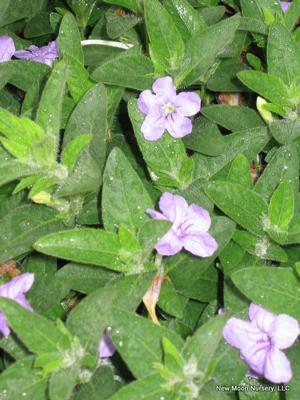Printed at http://www.newmoonnursery.com/index.cfm/
Ruellia humilis
Wild petunia
Native to North America
FIRST IMPRESSIONS: Ruellia humilis is a low mounding perennial wildflower. Multiple stems rise from the earth clad in oblong pubescent leaves. During summer plants are graced with lavender funnel shaped blooms for about two months. This adaptable species thrives in sunny sites with moist or dry soil.
HABITAT & HARDINESS: Ruellia humilis ranges through Eastern North American from Pennsylvania to Florida and west from Minnesota to Texas.
This species is indigenous to prairies, dry open woods, limestone glades, bluffs, sand flats, disturbed railroad right-of-ways, fields and roadsides. Plants often occur in thin soils over limestone.
Hardiness rating extends from USDA Zones 4-8.
PLANT DESCRIPTION: Ruellia humilis plants are upright or slightly sprawling with green pubescent stems and fibrous roots.
Leaves are opposite and about 3” long and 1” wide with oval or lance shaped blades. They are covered in white hairs and have a fringe of hairs along the margin.
In summer, light lavender or violet bell shaped flowers appear. Each bloom has five rounded flared lobes and is about 2” long. The center of each flower is marked with dark purple lines.
Blossoms can be solitary or in clusters in the upper leaf axils. Individual blooms last only a day but blooming continues for about 2 months. The flowers have scattered hairs and are reminiscent of small pubescent petunias.
After flowering oval seed capsules form and several large seed fall to the ground near the parent plant or are ejected as far as 10’.
Plants attain a 1-2’ height with 1’ spread.
CULTURAL & MAINTENANCE NEEDS: Ruellia humilis grows in sun or part shade with average or dry soils. Plants tolerate excess moisture or drought, sand, loam or dry rocky soils.
In garden situations, plants are more floriferous if they are irrigated. Plants commonly reseed but are not considered to be aggressive.
Plants are pest resistant and are somewhat unpalatable to deer, rabbits and livestock.
Excess shade and competition from neighboring plants can cause plants to weaken and decline.
LANDSCAPE USES: This is a good choice for a Pollinator Garden, Prairie or Meadow. Plants are also used as Butterfly Host Plants or as part of a Groundcover or Mass Planting. Ruellia humilis has Showy Blooms and can be utilized in Cottage Gardens, Deer Resistant Plantings, Rock Gardens, Water-wise Landscapes, Low Maintenance Plantings, Perennial Borders, Rain Gardens and Wildlife Gardens.
COMPANION & UNDERSTUDY PLANTS: Try pairing Ruellia humilis with Aster laevis, Coreopsis tripteris, Penstemon digitalis, Solidago nemoralis, Bouteloua curtipendula, Eragrostis spectabilis, Sorghastrum nutans or Schizachyrium scoparium.
Blephilia ciliata has similar height, flowers and cultural needs and can be substituted if needed.
TRIVIA: Long-tongued bees, short-tongued bees and syrphid flies seek nectar and pollen from the flowers. Some references suggest that hummingbirds, hummingbird moths and sphinx moths also visit the blooms. Plants host caterpillars of Buckeye Butterflies but foliage is unpalatable to deer and other herbivores.
Ruellia humilis is a member of the Acanthus Family (Acanthaceae). Despite the common name, this species is unrelated the petunia which is a member of the Nightshade Family (Solanaceae).
The genus was named for Jean Ruelle (1474-1537), a French herbalist, scholar, author and physician. The specific epithet is from Latin and means “low” due to the plant’s short stature.
Height:
1-2 ftSpread:
1 ftSpacing:
18 inUSDA Hardiness Zone:
4-8Bloom Color:
Lavender-BlueRuellia humilis Characteristics
Attracts Wildlife
- Pollinators
- Hummingbirds
- Butterflies
Attributes
- Drought Tolerant
Exposure
- Full Sun
Deer Resistant
- Deer Resistant
Flowering Months
- July
- June
- August
Foliage Color
- Green
Growth Rate
- Medium
Salt Tolerance
- High
Season of Interest (Foliage)
- Summer
- Spring
- Fall
Soil Moisture Preference
- Moist to Dry
Interesting Notes:
For more information on this plant, visit the USDA PLANTS Database: http://plants.usda.gov/java/profile?symbol=RUHU

